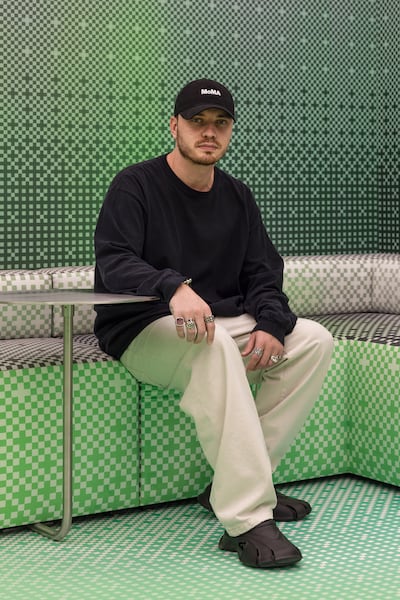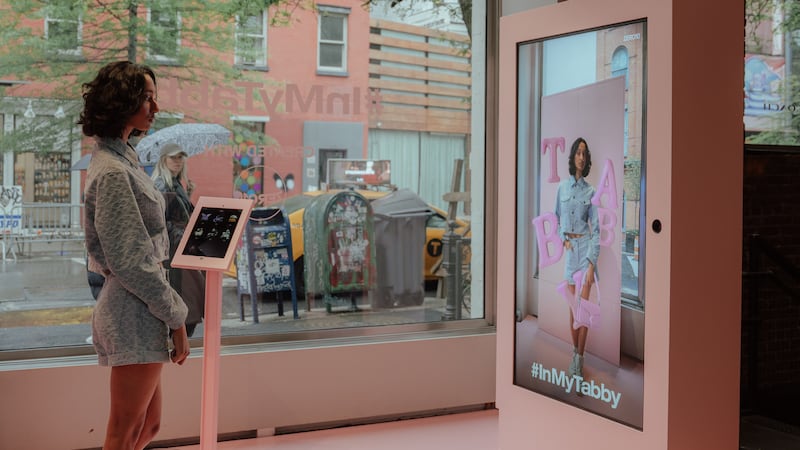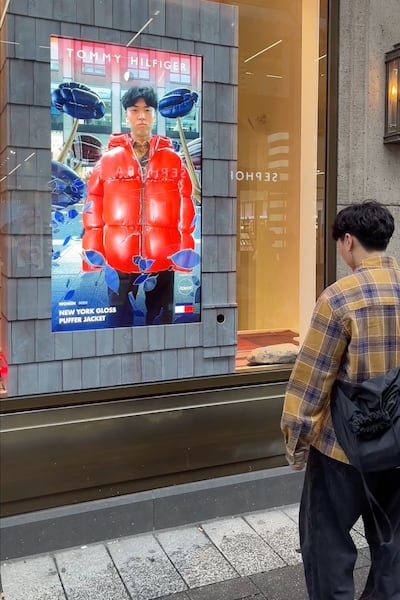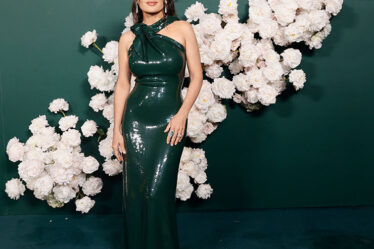
Globally, just 9 percent of consumers said they are content with the in-store shopping experience, while only 14 percent are content with their experience online, according to an IBM consumer survey of nearly 20,000 global consumers published in 2024.
The study also found heightened consumer interest in digital integration to improve their in-store and online experience. In recent years, as a means of enhancing engagement and interest in the in-store and online experience, fashion brands have begun to experiment with technological enhancements like augmented reality (AR) solutions.
AR superimposes computer-generated images over real-world imagery, such as one’s reflection in a digital mirror or through a phone camera lens. Brands and retailers can leverage this technology through apps, digital posters or via AR mirrors in-store. By mimicking real clothes and accessories on consumers, the technology allows retailers to virtually fit customers in seconds while creating an engaging store experience.
Some examples of early adopters include Gucci and Dior, who employ AR for categories like footwear and makeup. Tommy Hilfiger also uses technology company Zero10′s AR Mirrors in Europe as a part of their Shawn Mendes campaign and to promote their recent launch of puffer jackets. Meanwhile, Coach employs Zero10′s AR Mirror and AR storefront to publicise their Tabby bag and Holiday Season campaigns.
As well as providing AR and Al solutions for Tommy Hilfiger and Coach, Zero10 also works with Fusalp, Ugg, JD Group, Macy’s and Disney. Its flagship product, the AR Mirror, offers real-time try-on experience to help brands engage their audiences. The company is also exploring use cases for generative AI within the virtual try-on space, which would further deliver on evolving consumer preferences for the shopping experience — indeed, IBM’s survey found 59 percent of consumers are eager for AI applications as they shop.
Now, BoF sits down with Zero10′s co-founder and CEO, George Yashin, to learn more about the digital advancements in the AR space and how fashion companies can make the most of the technology by attracting and engaging consumers in-store, online and through virtual reality brand experiences.
Why is augmented reality a useful tool for fashion brands and retailers to attract consumer attention?
Augmented reality (AR) try-on technology presents various opportunities for fashion brands and retailers. The most obvious is enhancing customer engagement — because now, every brand, every retailer, is seeking the customer’s attention.
Despite the shift to online shopping during the pandemic, customers are now returning to brick-and-mortar stores in search of new experiences. Regular screens, which all retailers invested in maybe 10 to 12 years ago, are not performing at their maximum — all shop fronts and interiors look the same, offering the same experience.
However, AR screens, which we develop for store windows for example, allow people to try on clothes before even entering the store. This AR Storefront feature is an effective tool for immediately capturing the attention of a passer-by.
Coach — with whom we have done three projects now — is an innovative partner of ours that has efficiently leveraged the try-on technologies to enhance their campaigns, including their recent Holiday campaign. The impact was impressive — in the US, Coach’s Black Friday numbers recorded a 2.12x rise in users for installed AR window displays compared to previous engagement numbers recorded on a Friday. At one particular Coach US store, a performance comparison between the AR Storefront and a traditional display window revealed at least a 4.37x higher engagement rate for the virtual try-on experience.
How is AR then leveraged to engage consumers once in-store?
AR try-on technology allows customers to interact with products in-store using large screens — what we call AR Mirrors. Customers can engage with digital items, supported with special effects through AR enhancements. They can take photos or videos and, quite simply, have fun. It is similar to the AR filters and masks on social media platforms, which many consumers already use and enjoy — but because of the full-body screen, this experience is different and more exciting.
It is also a great tool for promoting new collections or specific items. Similar to how stores use merchandising and point of sale (POS) materials, it offers a more immersive way to highlight new products and capture customers’ attention. In addition to the try-on feature, brands can display product information or prices on the screen to increase its sales relevance. With the assistance of AI, we aim to enhance utility and personalisation, making this tool even more beneficial for driving sales.
AR mirrors […] can be integrated into clients’ existing hardware setups [making them] a great opportunity to repurpose old placements […] to reach out to a new audience effectively.
Another use case is integrating our virtual try-on (VTO) software into screens brands already have. They can offer an AR Mirror experience but customised to their needs, driving attention to their products. So, rather than simply viewing promotional videos, customers can try on collections directly, increasing their interest in visiting the store or remembering the brand and product.
Based on the results from our previous projects, we have seen a 9x increase in the customer engagement rate for virtual try-on mirrors compared to traditional ad formats.

What role does gamification play within this AR technology and how does it help brands engage the next generation of consumers?
We interact with the gaming industry a lot. Our first pilot project with gaming company Nexters debuted last year, taking advantage of the mixed world reality, as I call it. Through our partnership we offered their customers our Web Widget feature — a tool which allows brands to integrate our try-on tech into any device. This allowed their users to try on different gaming skins for their players.
Outside of online gaming environments, we are currently in conversation with one of our current clients about adding some simple games into the AR Mirror for the brand to “gamify” the shopping experience. We have our own 3D engine and creative teams in-house, so this is something that we can do — and I think this could be a simple and efficient way for brands to speak the same language as the new generation.
We recently worked with Macy’s and Disney to support Disney’s 100th Anniversary, which is still installed at Macy’s New York flagship now. We created an amazing installation for kids, recreating digital dresses of Disney princesses and allowing customers to become their favourite characters via our try-on technology.
AR mirrors and kids, or Gen Alpha, are a perfect match — considering their fluency with technology and gaming, they will grow up with these tech experiences becoming a usual part of their shopping habits.
How can brands strategically introduce AR technology for maximum effect?
The first thing brands need to do is understand the goals they want to achieve — setting clear goals is crucial. Based on these goals, together with the brand, we create concepts for 3D assets, decide what features to add, what calls to action (CTAs) to include and where it’s best to integrate the AR Mirror, whether as a window display or in-store.
We also consider factors like connecting it to offline stock. It needs to be part of a larger strategy, not a standalone element. Many brands miss this point, thinking that using this technology will instantly bring customers to the store or innovate the brand. We have had successful cases where the AR Mirror effectively promoted a collection and boosted sales dramatically — when placed near real products. But it’s not magic; it’s a well-planned activation.

Many believe that AR mirrors are hardware, but the primary component is our software, which can be integrated into clients’ existing hardware setups. It is a great opportunity to repurpose old placements and upgrade them with new technology to reach out to a new audience effectively.
What are critical next steps for sustained success with launching AR in-store?
Brands often overlook communicating about the AR Mirror with clients, staff, other departments and sales teams. It’s not enough to just install it; brands need to make an effort to let people know about it. We have seen cases where even the store staff weren’t aware of the activation or couldn’t answer customers’ questions.
It’s crucial for teams to understand and communicate the purpose of using this solution — that way they can better use it to achieve their goals. Brands should also set and measure key performance indicators (KPIs), and share them with the vendor. This is crucial because it helps us improve the tool as a provider and allows the brand to understand how effective the solution is — and how it can be used even more effectively.
How is Zero10 looking to integrate generative AI into its AR products?
Brands are already actively leveraging AI online to provide personalised recommendations and style assistance to make the experience and shopping more focused on individual customer preferences. We think it could be used for offline shopping too, such as by integrating an AI stylist in our existing solutions.
AR mirrors and kids, or Gen Alpha, are a perfect match — considering their fluency with technology and gaming.
We are working on integrating AI features into our AR Mirror, which has a lot of potential in terms of enhancing the personalisation aspect when engaging with virtual try-on. We have been working on our generative AI try-on minimum viable product (MVP) — an advanced product in its early stages — and presented our research at the end of last year.
What markets are you seeing this technology gaining the most traction?
Our main focus remains on fashion and retail but we are witnessing growing demand across sectors like entertainment, kids products, cinemas and theme parks, where entertainment and engaging experiences are paramount. A recent highlight includes our collaboration with Warner Bros. on the launch of the movie “Aquaman and the Lost Kingdom”. We enabled people to try on the costume of the main character using our AR Mirror, three weeks before the official release date, as part of the pre-launch campaign.
Geographically, our primary market is the USA, given its positions as one of the leading tech adopters. But we also observe significant demand in the MENA and APAC regions, where we plan to continue our expansion efforts this year. We have already completed several projects in these regions, including partnerships with Kayanee, a PIF company in Saudi Arabia, and Oroton, an Australian fashion brand.
This is a sponsored feature paid for by Zero10 as part of a BoF partnership.



